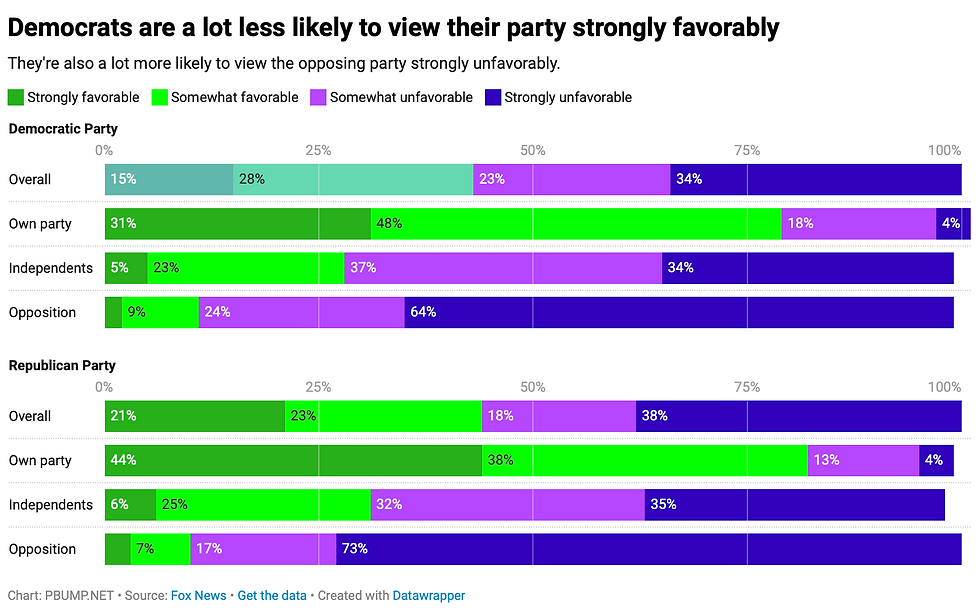Why Democrats Keep Winning Even When Their Party’s Losing— And Deserves To Be
- Howie Klein

- Jul 30
- 3 min read
The Democratic Party’s Identity Problem Is An Urgent Brand Crisis

Republicans hate the Democratic Party and Democrats hate the Republican Party. But here’s the crucial difference: Republicans like their own party, while Democrats are deeply dissatisfied with theirs. That helps explain why, in poll after poll this year, the Republican Party is outperforming the Democrats— even as Trump remains historically unpopular and his grip on the party unnerves many independent voters and even a handful of mainstream Republicans.
Philip Bump explored this paradox in a recent post, prompted by Wall Street Journal and Fox News polls showing that the Democratic Party is now viewed more unfavorably than at any point in the last 35 years— even less favorably than Señor TACO. Republicans, meanwhile, continue to give their party strong marks, both on leadership and on key issues. The Democratic Party? Not so much. Only half of Democrats think their own party has a clear plan to address the country's problems. Among Republicans, it's 8 in 10.
And yet… despite this widespread dissatisfaction with the party itself, Democrats still hold a narrow edge when voters are asked which party they plan to vote for in congressional races next year. They also hold the advantage on many key issues— even in polls conducted by Fox. It’s not the policies or the candidates that voters are rejecting; it’s the party— or, more accurately, the muddled and uninspiring way it presents itself.
Bump argues that this isn’t new. In fact, it reflects a deeper truth about American politics in the Trump era: parties are increasingly something to run against, not with. Trump himself won the GOP nomination by running against the Republican establishment. Bernie surged in 2016 and 2020 by doing the something similar on the left. And some of the most effective anti-Trump organizing— like rallies headlined by Sanders and AOC— has come from outside the official Democratic Party framework. These voices, unburdened by party orthodoxy and donor constraints, are always more compelling and trusted.

The problem for Democrats is that too many voters— including Democratic voters— no longer see the party as standing for anything concrete or coherent. The “D” next to a candidate’s name still means something, but what exactly that is has become increasingly unclear. Until that changes, Democrats may continue to be rescued by voter revulsion toward Republicans… but they won’t inspire the kind of loyalty that wins landslides or builds enduring power.
This lack of definition is particularly glaring on the biggest issues of the day. Ask ten Democrats what the party stands for on Gaza, on climate, on healthcare or on the economy, and you’ll get ten different answers— some passionately contradictory. Voters see a party that tiptoes around tough choices, triangulates instead of leading, and waters down bold ideas in pursuit of a mythical bipartisan center that no longer exists. The contrast with Republicans, who may be wrong but are rarely unclear, is stark.
Even on issues where Democrats have the popular position— abortion rights, gun safety, taxing the rich— the party often fails to convey urgency or conviction. Messaging is muddled, leadership is cautious, and too often the party’s top figures seem more concerned with appeasing donors or managing internal factions than with mobilizing voters. That vacuum of purpose is why so many progressives feel alienated, independents remain skeptical, and even loyal Democratic voters don’t feel particularly energized.
And yet, for all this dissatisfaction with the Democratic Party as an institution, Democratic candidates continue to defy expectations at the ballot box. In special election after special election this year, Democrats have overperformed— sometimes dramatically— compared to baseline partisan expectations, in swing districts, in blue districts and in red districts. They’re also polling well ahead in both of the major 2025 off-year contests: the gubernatorial and legislative elections in Virginia and New Jersey. These aren’t just flukes. They point to a critical dynamic: voters may not love the Democratic Party, but they’re still choosing Democratic candidates when the stakes are clear and the alternative is MAGA extremism.
This disconnect between institutional weakness and electoral resilience is both a warning and an opportunity. It shows the limits of the party brand— but also the potential for strong candidates— like Zohran Mamdani for example— with clear issue framing and grassroots energy to overcome those limits. The question is whether the Democratic establishment can learn from this… or whether the party will continue drifting, leaving it to sporadic anti-red waves like the one forming up for next year and to individual candidates to carry the weight on their own.







Party mandarins, having totally missed the boat last year (not to mention in other cycles) are now missing the lifeboat, too:
Democratic mayoral nominee Zohran Mamdani looks to be cruising toward victory, capturing 50 percent of the vote in a new general election poll of the mayor’s race paid for by his allies.
In the five-way contest, Andrew Cuomo trailed him with 22 percent, Republican nominee Curtis Sliwa came in third at 13 percent and Mayor Eric Adams captured 7 percent of the vote among likely voters. Attorney Jim Walden received 1 percent.
https://www.politico.com/newsletters/new-york-playbook-pm/2025/07/29/zohran-dominates-in-new-poll-00481956